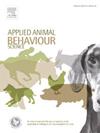一个温和的程序会减少肉鸡对人类的恐惧行为,但不会减少对新事物的恐惧行为
IF 2
2区 农林科学
Q1 AGRICULTURE, DAIRY & ANIMAL SCIENCE
引用次数: 0
摘要
人与动物的关系是良好动物福利的一个重要方面。这方面的改进可能与鸡特别相关,因为在商业饲养条件下,鸡与人类的关系通常仅限于每天进行简短的动物检查(目视接触)。经常与人接触可以潜在地减少鸡对人的恐惧反应,但要做到这一点,通常需要长时间的几周适应。在这项研究中,我们调查了在出生后3天内短暂的“温和”(即鸡可能认为是积极的标准化人与动物的互动)是否足以减少肉鸡对人类的恐惧反应。六组约220只(214 - 254)日龄的肉鸡雏鸡,每只雏鸡在到达后都被暴露在人类的温和程序中。同样数量的对照组除了常规的饲养程序外不与人接触。我们对鸡进行了三次行为测试,以评估它们对人类的恐惧。一个静止的人测试(SPT)测量了自愿接近一个站立的人,一个回避距离测试(ADT)测量了对一个接近的人的回避行为,一个触摸测试(TT)测量了对一个蹲着的人的接近行为,然后测量了接近的手的回避行为。此外,还进行了一项新对象测试(NOT),以评估潜在的恐惧减少是否仅限于人类。试验在3个不同年龄的鸡(第7、21和36天)进行。在所有与人类相关的试验中,温和组的鸡比对照组的鸡对人类表现出更少的回避和更多的接近行为(SPT: p = 0.004,ADT: p = 0.001,TT: p = 0.035)。NOT的结果显示,在统计学上,温和组和对照组之间没有显著的行为差异(p = 0.205),证实了小鸡的恐惧反应不是普遍的,而是特定于人类相关测试的。目前的研究表明,在小鸡出生后的前3天,对其进行温和处理,可以在至少36天内改善人与动物的关系。本文章由计算机程序翻译,如有差异,请以英文原文为准。
A gentling program decreases fear-related behaviour towards humans but not towards novel objects in broiler chickens
The human-animal-relationship is a crucial aspect of good animal welfare. Improvements in this regard might be particularly relevant for chickens, as their relationship with humans in commercial husbandry conditions is often limited to brief animal inspections (visual contact) on a daily basis. Regular human contact can potentially reduce fear responses towards humans in chickens, but to achieve this, a long period of several weeks of habituation is usually required. In this study, we investigated whether a short period of ‘gentling’ (i.e. standardised human-animal interactions that the chicks are likely to perceive as positive) within the first 3 days of life would be sufficient to reduce fear responses towards humans in broiler chickens. Six groups of ca. 220 (214 – 254) day-old broiler chicks each were exposed to a gentling program by a human after arrival. The same number of control groups received no human contact apart from routine husbandry procedures. We performed three behavioural tests on the chickens to assess their fear of humans. A stationary person test (SPT) measured the voluntary approach to a standing human, an avoidance distance test (ADT) measured the avoidance behaviour towards an approaching human while a touch test (TT) measured the approach behaviour towards a squatting person followed by the measurement of the avoidance behaviour from the approaching hand. Additionally, a novel object test (NOT) was performed to assess whether a potential fear reduction would be limited to humans. The tests were conducted at three different ages of the chickens (day 7, 21 and 36). In all human-related tests, chickens of the gentled groups showed less avoidance and more approach behaviour towards the human than chickens of the control groups (SPT: p = 0.004, ADT: p = 0.001, TT: p = 0.035). The results of the NOT showed statistically no significant behavioural differences between the gentling and control groups (p = 0.205), confirming that the chicks' fear responses are not generalised but specific to human-related tests. The present study suggests that gentle handling of chickens during the first 3 days of life can improve the human-animal-relationship for at least 36 days.
求助全文
通过发布文献求助,成功后即可免费获取论文全文。
去求助
来源期刊

Applied Animal Behaviour Science
农林科学-行为科学
CiteScore
4.40
自引率
21.70%
发文量
191
审稿时长
18.1 weeks
期刊介绍:
This journal publishes relevant information on the behaviour of domesticated and utilized animals.
Topics covered include:
-Behaviour of farm, zoo and laboratory animals in relation to animal management and welfare
-Behaviour of companion animals in relation to behavioural problems, for example, in relation to the training of dogs for different purposes, in relation to behavioural problems
-Studies of the behaviour of wild animals when these studies are relevant from an applied perspective, for example in relation to wildlife management, pest management or nature conservation
-Methodological studies within relevant fields
The principal subjects are farm, companion and laboratory animals, including, of course, poultry. The journal also deals with the following animal subjects:
-Those involved in any farming system, e.g. deer, rabbits and fur-bearing animals
-Those in ANY form of confinement, e.g. zoos, safari parks and other forms of display
-Feral animals, and any animal species which impinge on farming operations, e.g. as causes of loss or damage
-Species used for hunting, recreation etc. may also be considered as acceptable subjects in some instances
-Laboratory animals, if the material relates to their behavioural requirements
 求助内容:
求助内容: 应助结果提醒方式:
应助结果提醒方式:


